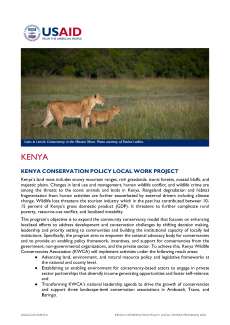Kenya’s land mass includes snowy mountain ranges, rich grasslands, iconic forests, coastal bluffs, and majestic plains. Changes in land use and management, human wildlife conflict, and wildlife crime are among the threats to the iconic animals and lands in Kenya. Rangeland degradation and habitat fragmentation from human activities are further exacerbated by external drivers including climate change. Wildlife loss threatens the tourism industry which in the past has contributed between 10-15 percent of Kenya’s gross domestic product (GDP). It threatens to further complicate rural poverty, resource-use conflict, and localized instability.
This program’s objective is to expand the community conservancy model that focuses on enhancing localized efforts to address development and conservation challenges by shifting decision making, leadership and priority setting to communities and building the institutional capacity of locally led institutions. Specifically, the program aims to empower the national advocacy body for conservancies and to provide an enabling policy framework, incentives, and support for conservancies from the government, non-governmental organizations, and the private sector.

